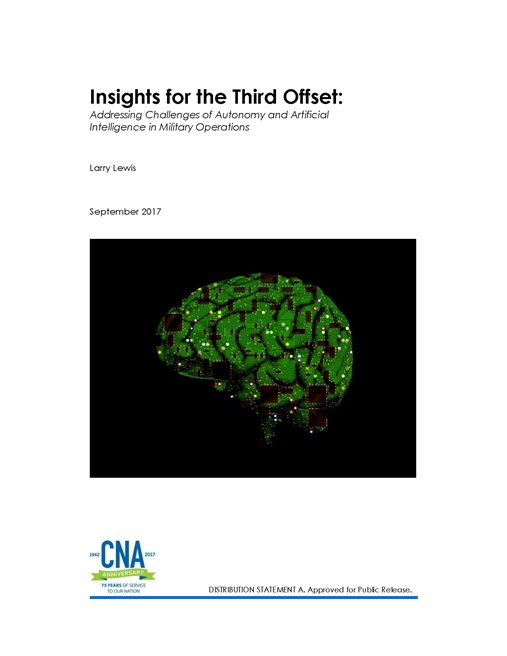Throughout history, the ability to adapt technological advances to warfighting has led to fundamental changes in the character of war and the tools used in its conduct. Examples include the development of the crossbow; gunpowder-powered projectile weapons; chemical weapons in World War I; rockets, jet aircraft, and nuclear warheads in World War II; and stealth, unmanned vehicles, and precision-guided munitions in recent decades. Military operations are poised for a revolutionary change with the rapid and advancing progress in artificial intelligence, including the attribute of autonomy. Dominated by the commercial industry and its innovations, the past two years have seen dramatic advances in which machines have been able to complete complex tasks and match or exceed human performance. This trend is expected to continue.
At the same time, key technologies behind the military edge of the United States have proliferated to other pacing competitors, which now have capabilities comparable to those of the U.S. and have developed ways to counter traditional U.S. military strengths. The U.S. response to this new security environment is the “Third Offset” strategy, an asymmetric approach that aims to “exploit all the advances in artificial intelligence and autonomy … to achieve a step increase in performance that the department [U.S. Department of Defense] believes will strengthen conventional deterrence.”
Unlike past offset strategies, this approach must reflect the new reality that for the underlying technology, commercial research and development (R&D) efforts will dwarf that of the U.S. military. Thus the Third Offset must rely on developments in the commercial sector as well as DOD’s R&D programs. Of course, commercial development will be equally exploitable by many states—and by non-state actors for that matter—so the ability to quickly identify developments and integrate them into fielded systems will be critical in this new, rapidly evolving technological environment. This creates challenges for a U.S. military characterized by a slow and deliberate acquisition process. In addition, the U.S. military has struggled to integrate technologically advanced systems to date, plagued by significant and persistent interoperability challenges that both reduce effectiveness and increase the risk of fratricide and civilian casualties. These interoperability challenges could be even more significant for autonomous systems.
At the same time, the most controversial aspect of this new technology—should weapon systems operating autonomously (without a human operator) be allowed to use lethal force—could have significant impact on the ability and will of the U.S. to field and use such systems. About a dozen states and some nongovernmental organizations (NGOs), along with some prominent scientists, have been vocal about a preemptive ban on such weapons, citing concerns about civilian casualties, the difficulties of machines complying with international humanitarian law (IHL), and other ethical considerations. Likewise, U.S. operators and senior leaders will need to decide that these systems are reliable and can be trusted on the battlefield. And our allies are already expressing some concerns regarding the use of these new technologies in war, which could strongly impact current and future coalition operations. These are all audiences the U.S. will need to consider, at the same time that other states are moving rapidly toward the use of autonomous systems and the militarization of artificial intelligence overall.
This report examines each area of concern, based on CNA’s experience in conducting objective analysis of U.S. military operations, as well as its expertise in autonomy and other aspects of AI. Though much of the emerging technology is new, the approach of applying lessons from U.S. operations and institutional processes to key challenges in leveraging autonomy and AI continues CNA’S applied research paradigm of exploring many opportunities to resolve or work around challenges that have been seen before. The report concludes with concrete recommendations for better leveraging these technologies in support of the Third Offset strategy. It also discusses how this effort does not have to sacrifice U.S. principles and values for military effectiveness. Both goals are possible: making autonomy and AI militarily effective from an acquisition and operational perspective, and pursuing these capabilities in ways that are consistent with longstanding U.S. principles in the advancement of broader U.S. national interests.
Many advances, some unforeseeable, are expected in the coming decades because of technological advances involving autonomy and AI. At the same time, there are actions the U.S. can take now to best prepare for these advancements and leverage them effectively. This report details four deliberate efforts needed in the near term to overcome key challenges in leveraging autonomy and AI in the Third Offset.
Download reportDISTRIBUTION STATEMENT A. Approved for Public Release.
Details
- Pages: 84
- Document Number: DRM-2017-U-016281-Final
- Publication Date: 9/1/2017
